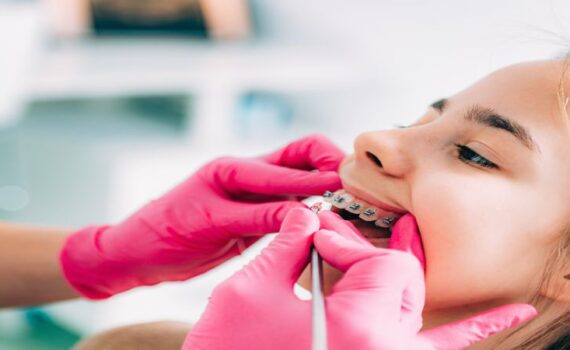Everyone wants a set of healthy, perfectly aligned teeth – one that will give them the most beautiful smile. Unfortunately, many people suffer from a bad bite, overcrowded mouth, unevenly spaced teeth, and misaligned teeth. If you are one of those people, then you probably already know how detrimental these problems can be for your self-esteem. To make matters worse, they can also lead to more serious dental and health complications down the road.
The situation might seem hopeless, but there are plenty of ways around it. In fact, all you need is a skilled dentist or orthodontist. After treatment, you can finally have the teeth of your dreams while reclaiming your long-lost confidence. Read on to find out how.
What Are the Top Reasons to Have Orthodontic Treatment?
Orthodontic treatment is all about straightening and moving the teeth to improve their appearance and overall function. In other words, it is done for both practical and aesthetic purposes.
Having overcrowded or crooked teeth and improper bite are the main reasons to get orthodontic treatment. Aside from negatively affecting your appearance, these two issues can also lead to gum diseases and other health complications – including temporomandibular joint (TMJ) disorders – if left untreated. You may experience chewing and speaking problems as well. By straightening your teeth and correcting your bite, you can chew properly while reducing bite pressure and strain. Ultimately, this promotes the long-term health of your teeth, gums, and jaw.
To achieve this, your dentist or orthodontist – a type of dentist specializing in tooth and jaw alignment – will use various dental appliances, such as braces, headgear, and plates. He/she may also perform certain procedures, including tooth repair, removal, or, in some cases, surgery.
Bite issues are one of the most common reasons to undergo orthodontic treatment. Ideally, your upper and lower teeth should align with each other when you bite. If you look at yourself in the mirror, you should see your upper teeth sitting slightly over your lower teeth. That is, the fronts of the upper teeth should gently touch the fronts of the lower ones. Furthermore, you should not notice any spacing or excessive overlapping between the upper and lower teeth. Meanwhile, your molars should fit the indentation of the opposite molars.
If your teeth do not align properly, then you have a bad bite, otherwise known as a “malocclusion.” This can distort your facial appearance, taking a toll on your self-esteem. Even worse, a misalignment problem can also lead to other health complications, including:
- Chewing and biting issues
- Speech problems
- Breathing difficulties
- Teeth grinding
- Jaw and joint problems (such as TMJ)
- Headaches and shoulder or back pain
Most alignment issues are relatively minor and can be rectified with orthodontic treatment. To get a healthy, normal bite, your dentist or orthodontist will typically perform any or a combination of the following procedures:
- Braces to improve bite and teeth alignment
- Tooth extraction to address overcrowding
- Tooth repairs, such as capping, bonding, or reshaping
- Corrective jaw surgery to reshape, lengthen, or shorten the jaw
Overcrowding – also referred to as “dental crowding” – typically occurs when there is not enough room in the gums for permanent teeth to grow in. This can be due to having large teeth or a small mouth, or not having adequate space in the jaw. As the teeth get crammed together, they may start to overlap, rotate, or get trapped behind a row of teeth.
As one might expect, overcrowding can cause misalignment and biting issues. Another pressing concern is that it can make it harder for you to clean your teeth. If left unaddressed, it can lead to problems like:
- Cavities
- Tooth decay
- Gum disease
Related Article: What Causes Gum Disease and How to Prevent or Treat
The type of treatment depends on various factors, including the severity of the crowding and the patient’s age. For younger patients, a dentist may recommend tooth removal to prevent overcrowding in the future. Meanwhile, for adults, permanent tooth extraction, braces, and a palate expander are the most common treatment option. However, surgery may also be necessary in some cases.
Having unevenly spaced teeth is, in a way, the exact opposite of dental crowding. As the name suggests, this problem occurs when there is too much room in the mouth. Often, it arises due to missing or small teeth size, oversized jaws, or a combination of these factors. As one might expect, having a large gap in between the teeth can make you self-conscious. On top of that, it can also cause the food to get stuck in between the crevices, resulting in cavities and gum disease.
If you are suffering from unevenly spaced teeth, you will be glad to know that there are several treatment options available. In general, the larger the gap, the more complicated and the more expensive the procedure. With that said, here are some of the most common treatments that your dentist or orthodontist may prescribe:
- Dental bonding to close small gaps between the teeth
- Dental veneers to change the size, shape, or appearance of the teeth
- Dental implants to replace the teeth**
- Dental bridges to fill the gap between the teeth**
- Braces to move the teeth to their ideal position**
** These procedures are usually recommended for larger gaps.
At the first glance, breathing difficulties like heavy snoring and sleep apnea – which occurs when your breathing stops and starts periodically during sleep – may seem completely unrelated to orthodontics. However, these problems typically occur when you breathe through your mouth. While habitual mouth breathing is more commonly caused by nasal congestion, it can also stem from improper bite and teeth positioning. As discussed earlier, these are easily resolved by orthodontic treatment.
Speaking difficulties may occur for a variety of reasons. Some are caused by brain damage and muscle weakening, while others are due to dental problems, such as having a bad bite, improper jaw alignment, and overcrowded mouth. Hence, if you have trouble speaking and experience any of the above problems, you will certainly benefit from orthodontic treatment. In general, a dentist will recommend orthodontic appliances like braces or aligners to move your teeth into the right position, making it easier for you to speak.
Protruding teeth – also called “buck teeth” – refer to front teeth that are jutting out at an odd angle. Often, it occurs when the upper jaw is too far forward or when the lower jaw is too far back. Alternatively, it can be caused by teeth that simply erupted at an unnatural angle. Bad habits during childhood – such as sucking the thumb – are also a common culprit.
If left untreated, the protrusion of the teeth can result in the accidental breakage of the teeth, difficulty in closing the mouth (resulting in excessive oral dryness and, ultimately, tooth decay), and speaking problems. As if these are not enough, it can also cause the face to elongate.
To fix buck teeth, dentists and orthodontists typically recommend the use of braces.
When Is Orthodontic Treatment Optional?
In some scenarios, orthodontic treatment is not necessary but is only done for cosmetic reasons. For example, if your teeth are not perfectly straight, it does not automatically mean that you need to seek orthodontic treatment. As long as you have a healthy bite and do not have difficulty chewing, you are good to go. However, you may still want to wear braces to feel comfortable and happy with your smile. That is enough reason to visit your dentist.
Get Orthodontic Treatment for Healthier Teeth and a More Confident Smile
For some people, orthodontic treatment is a matter of necessity. Meanwhile, for others, it is all about having a better appearance and feeling more confident about themselves. Whatever the case, one thing is for sure: an orthodontic treatment is a long-term investment.
While some procedures may seem costly upfront, they go a long way in keeping your teeth healthy and well-functioning. More than that, they also do wonders for your oral health, as well as your overall mental and physical well-being. Best of all, the right orthodontic treatment can help you live more in the present and regain your self-esteem. Now, you can finally smile in public without reserve. Call Fort Lauderdale Dentist today.



